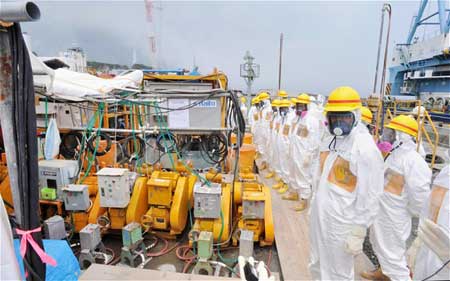
|
Japan's prime minister Thursday ordered his government to find "multiple, speedy and sure" ways to stop the spread of radioactive groundwater around the meltdown-stricken Fukushima Daiichi nuclear power plant, including freezing the surrounding ground. Prime Minister Shinzo Abe's directive comes two weeks after the Tokyo Electric Power Company admitted that contaminated water was leaching into the Pacific Ocean from the plant, the site of the worst nuclear accident in a quarter-century. "This is not an issue where we can let TEPCO take complete responsibility," Abe told reporters at the government's nuclear disaster response headquarters. "We have to deal with this at a national level." Abe said he has told Japan's Ministry of Trade and Industry to "provide multiple, speedy and sure solutions to this issue." The ministry has proposed setting up a subterranean barrier around the plant by freezing the ground around it, preventing groundwater from leaking into the damaged plant and carrying radioactive particles with it as it seeps out. The public has a strong concern over the contaminated water problem, and this is an urgent issue to solve," Abe said. "We will not leave it only to TEPCO, but will lay out firm measures." That will mean a still-undetermined amount of direct government spending to aid the ailing utility, Yoshihide Suga, Japan's chief cabinet secretary, told reporters. Building a frozen wall around the plant is "unprecedented," he said. "To build such a wall, the government should take the lead to promote this kind of project," Suga said. "We have to provide the support to do so." TEPCO, the country's largest utility, has been grappling with water issues ever since the Fukushima Daiichi plant was hit by the March 2011 earthquake and tsunami that devastated eastern Japan. Scientists who monitor radiation levels offshore have pointed to persistent high readings as evidence of an ongoing leak for more than a year, but the utility did not publicly admit the problem until late July. Vast stands of storage tanks have grown up around the plant as TEPCO tries to manage the hundreds of tons of water involved every day, and the company has built an underground barrier to prevent contaminated groundwater from reaching the sea. But it remains a difficult problem, Masayuki Ono, TEPCO's acting nuclear power chief, said earlier this week. "It's a present reality that the contaminated water is seeping out to the bay without us being able to control it," Ono said. TEPCO is also pumping hundreds of tons of water a day into the plant to cool the crippled reactors two and a half years later, though most of that fluid is recycled. The 2011 tsunami swamped the plant, located 240 km (150 miles) north of Tokyo, and knocked out power to cooling systems for the three reactors that were operating at the time. The result was the second-worst nuclear accident in history, trailing only the 1986 disaster at Chernobyl, in the former Soviet Union. Meltdowns and hydrogen explosions spewed radioactive particles across many of the surrounding towns, complicating an already historic disaster. Though no deaths have been directly attributed to the accident, tens of thousands of people from towns as far as 25 miles away have been displaced by the disaster. In July, TEPCO disclosed that water from test wells around the reactor buildings showed concentrations of radioactive tritium in one well as high as 500,000 bequerels -- a unit of radioactive intensity -- per liter of water. By comparison, Japan's maximum safe level of radioactivity in drinking water for adults is 300 bequerels per liter. Another reactor byproduct, strontium-90, has been showing up in increasing concentrations as well, said Ken Buesseler, a marine radiochemist at the Woods Hole Oceanographic Institute in the United States. Strontium-90 mimics calcium in the body, seeking out bone in animal life. Buesseler said the amount of radioactive material leaking from the plant now is a small fraction -- about one ten-thousandth -- of what poured out of the plant in the weeks following the meltdowns. But while TEPCO's admission was not news to scientists, "What's less clear to me is how much this has changed in the last month," he said. "And I think that's part of the urgency." Michael Friedlander, a former nuclear plant operator and engineer, told CNN on Tuesday that the current problem may leave TEPCO and the Japanese government with two choices sure to stoke further public anger: "You can either dump it in the ocean, or you can evaporate it." "At the end of the day, collecting 400 tons of water every single day is not a sustainable solution," he said. Federal officials allowed the Three Mile Island nuclear plant in Pennsylvania, the site of the worst American nuclear accident, to let contaminated water evaporate, Friedlander said -- but TMI was nowhere near the scale of the Fukushima disaster. "We're in uncharted territory here," he said. |
綜合外國媒體8月8日報道,日本福島第一核電站核泄漏事件愈演愈烈,每天約有數(shù)百噸受放射性污染的水流向大海。日本首相安倍晉三表示,核電站污水問題需要提升至“國家層面”解決,他要求政府采取主動措施應(yīng)對緊急情況。 ***每天超過300噸污水流向大海 日本政府的原子能災(zāi)害對策總部7日公布估算結(jié)果稱,福島第一核電站每天約有超過300噸污水流向大海。日本產(chǎn)業(yè)經(jīng)濟省一位主管能源政策的官員也確認這一點。分析認為,地下水是在核電站廠區(qū)內(nèi)遭受放射性污染并流出的。 估算結(jié)果顯示,福島第一核電站1至4號機組周邊每天流動著約1000噸地下水,其中約400噸流入反應(yīng)堆廠房地下,剩余600噸地下水中約有一半流入與廠房相連的坑道后,遭滯留在其中的高濃度污水污染,流向大海。還有約300噸地下水則是在未遭污染的情況下流向大海。 日本政府和東京電力公司正在考慮采取盡快抽取護岸附近的地下水以減少污水流出量的方法。據(jù)悉,截至明年9月,污水抽取量將達到約4萬噸。日本經(jīng)濟產(chǎn)業(yè)省資源能源廳負責人表示,將在廠房內(nèi)增設(shè)儲罐,以暫時存放抽取的污水。 ***日政府建議構(gòu)筑“凍土擋水墻” “目前,單憑東京電力公司的一己之力已經(jīng)無法承擔起全部責任,這一問題需要提升到國家層面進行解決。”日本首相安倍晉三要求經(jīng)濟產(chǎn)業(yè)省采取“多樣的、快速的、有效的”解決措施,“公眾非常關(guān)注福島第一核電站的污水問題,此事亟需解決。我們不能把問題丟給東京電力公司,我們要制定確實有效的應(yīng)對方案”。 此前,日本經(jīng)濟產(chǎn)業(yè)省曾建議凍結(jié)福島第一核電站廠房周圍的土壤,設(shè)立擋水墻阻止地下水流入。其具體實施方法為,用“凍土擋水墻”把福島第一核電站的1至4號機組圍起,挖掘約1.4公里的地面,每隔1米向排列在地下的管道注入冷卻材料,令其周圍土壤凍結(jié)阻止地下水的流動。日本政府認為,該方法擋水效果好、施工難度低。預(yù)計施工費用為數(shù)百億日元。 日本內(nèi)閣官房長官菅義偉表示,在福島第一核電站周圍構(gòu)筑凍土擋水墻是“空前之舉”。“啟動這樣一個大項目,政府應(yīng)該帶頭推進,我們必須提供相應(yīng)的支持。”菅義偉稱,這意味著政府將伸出援手、給予撥款,而撥款的具體數(shù)目尚不得而知。 ***水樣中放射性物質(zhì)濃度上升 7月,日本東京電力公司公布對福島第一核電站周圍觀測井的水樣抽檢結(jié)果。抽檢結(jié)果顯示,其中一口觀測井的井水中檢出高濃度的放射性物質(zhì)氚,數(shù)值為每公升50萬貝克勒爾。而根據(jù)日本飲用水的安全標準,每公升最多只能含有300貝克勒爾。此外,檢測水樣中另一種放射性物質(zhì)鍶-90的濃度在不斷上升。 美國伍茲霍爾海洋研究所稱,與2011年福島第一核電站發(fā)生核泄漏事故時相比,現(xiàn)在核電站泄露出的放射性物質(zhì)只是一小部分,約為萬分之一。不過,布耶斯勒指出,“我不太清楚的是,過去一個月里放射性物質(zhì)的濃度變化了多少。我認為這是造成事態(tài)緊急的部分原因”。 邁克爾?弗里德蘭登曾在核電站工作,擔任操作員和工程師。他認為當前態(tài)勢只留給日本政府和東京電力公司兩個選擇,而這兩個選擇都會激怒民眾。“只能把污水倒入海洋或者蒸發(fā)掉,畢竟每天抽取400萬噸污水不是長久之策。”弗里德蘭登稱,美國聯(lián)邦政府曾允許發(fā)生核泄漏事故的三里島核電站蒸發(fā)受放射性污染的水,但是三里島核事故的規(guī)模遠遠小于福島核事故,“所以,我們正處于一個未知的領(lǐng)域”。 相關(guān)閱讀 美發(fā)布旅行預(yù)警 回應(yīng)基地組織威脅 (譯者 肉肉融 編輯 王琦琛) |
